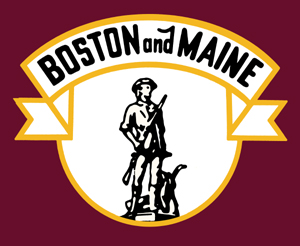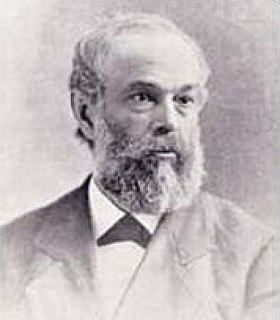
The Boston and Maine Railroad was a U.S. Class I railroad in northern New England. Originally chartered in 1835, it became part of what was the Pan Am Railways network in 1983.

The Grand Trunk Railway was a railway system that operated in the Canadian provinces of Quebec and Ontario and in the American states of Connecticut, Maine, Michigan, Massachusetts, New Hampshire, and Vermont. The railway was operated from headquarters in Montreal, Quebec, with corporate headquarters in London, United Kingdom. It cost an estimated $160 million to build. The Grand Trunk, its subsidiaries, and the Canadian Government Railways were precursors of today's Canadian National Railway.
The Central Vermont Railway was a railroad that operated in the U.S. states of Connecticut, Massachusetts, New Hampshire, New York, and Vermont, as well as the Canadian province of Quebec.

The St. Lawrence and Atlantic Railroad, known as St-Laurent et Atlantique Quebec in Canada, is a short-line railway operating between Portland, Maine, on the Atlantic Ocean, and Montreal, Quebec, on the St. Lawrence River. It crosses the Canada–US border at Norton, Vermont, and Stanhope, Quebec, and is owned by short-line operator Genesee & Wyoming.

The Maine Central Railroad Company was a former U. S. Class I railroad in central and southern Maine. It was chartered in 1856 and began operations in 1862. By 1884, Maine Central was the longest railroad in New England. Maine Central had expanded to 1,358 miles (2,185 km) when the United States Railroad Administration assumed control in 1917. The main line extended from South Portland, Maine, east to the Canada–United States border with New Brunswick, and a Mountain Division extended west from Portland to St. Johnsbury, Vermont and north into Quebec. The main line was double track from South Portland to Royal Junction, where it split into a "lower road" through Brunswick and Augusta and a "back road" through Lewiston, which converged at Waterville into single track to Bangor and points east. Branch lines served the industrial center of Rumford, a resort hotel on Moosehead Lake and coastal communities from Bath to Eastport.

The Quebec Central Railway was a railway in the Canadian province of Quebec, that served the Eastern Townships region south of the St. Lawrence River. Its headquarters was in Sherbrooke. It was originally incorporated in 1869 as the Sherbrooke, Eastern Townships and Kennebec Railway, and changed its name to the Quebec Central Railway in 1875. In 1894, it built a line southward to Mégantic to connect to Canadian Pacific Railway's east-west line, the International Railway of Maine. It would eventually own around 300 miles (483 km) of track. In 1912, the Canadian Pacific Railway leased the Quebec Central for 99 years but continued to operate as Quebec Central Railway, including passenger service to American cities. The Quebec Central in turn leased the Massawippi Valley Railway, a short line from Lennoxville to Newport, in 1926; this allowed passenger service from Quebec City via Sherbrooke to the United States.

The International Railway of Maine was a historic railroad constructed by the Canadian Pacific Railway (CPR) between Lac-Mégantic, Quebec, and Mattawamkeag, Maine, closing a key gap in the railway's transcontinental main line to the port of Saint John, New Brunswick.

The Portland & Ogdensburg Railroad was a railroad planned to connect Portland, Maine to Ogdensburg, New York. The plan failed, and in 1880 the Vermont section was reorganized and leased by the Boston & Lowell Railroad. In 1886, the Maine and New Hampshire section was reorganized as the Portland & Ogdensburg Railway. That part was leased to the Maine Central Railroad in 1888, and in 1912 the Maine Central leased the eastern part of the Vermont section from the Boston & Maine Railroad, the successor to the B&L.
The Canada Atlantic Railway Company (CAR) was a historic North American railway located in Ontario, southwestern Quebec and northern Vermont. It connected Georgian Bay on Lake Huron with the northern end of Lake Champlain via Ottawa. It was formed in 1897 through a merger of three separate railway companies that John Rudolphus Booth had either purchased or created, beginning in 1879. The CAR was owned by Booth for eight years after its formation until he sold it to the Grand Trunk Railway (GTR) in 1904.
The Washington County Railroad is a shortline railroad operating in Vermont and a sliver of New Hampshire, forming part of the Vermont Rail System. The WACR began operating in 1980 over the old Montpelier and Barre Railroad in Washington County, which the state acquired to ensure the continuance of rail service, and ceased operations in early 1999. Later that year, after interim service by other companies, operations were transferred to a new WACR subsidiary of the Vermont Rail System. In 2003, operations were greatly expanded through acquisition by the state and operation by the WACR of a former Boston and Maine Corporation and Canadian Pacific Railway line between Newport and White River Junction, which had most recently been operated by subsidiaries of the bankrupt Bangor and Aroostook Railroad.

The North Stratford Railroad was an interstate railroad in northeastern Vermont and northwestern New Hampshire. It ran from the village of North Stratford, New Hampshire to the village of Beecher Falls in Canaan, Vermont, a distance of approximately 23 miles (37 km).

The Montreal and Southern Counties Railway Company was an electric interurban streetcar line that served communities between Montreal and Granby from 1909 until 1956. A second branch served the city of Longueuil. Operated by the Canadian National Railway (CN), the M&SCRC ran trams on tracks in the street in Montreal and closer South Shore communities, and on separate right of way in rural areas.

The Mountain Division is a railroad line that was once owned and operated by the Maine Central Railroad (MEC). It stretches from Portland, Maine on the Atlantic Ocean, through the Western Maine Mountains and White Mountains of New Hampshire, ending at St. Johnsbury, Vermont in the Northeast Kingdom. The line was abandoned in 1983 by MEC's successor, Guilford Transportation Industries (GTI). Guilford retained a stub between Portland and Westbrook. A section in New Hampshire remains in use by heritage railway Conway Scenic Railroad.
Highwater is a village in the Potton township of the Eastern Townships of Quebec, Canada, in Memphrémagog Regional County Municipality of the Estrie region, north of the Canada–United States border from North Troy, Vermont. The Portland-Montreal Pipe Line crosses the border and there is pumping station on the Highwater side. Highwater was the site of the Space Research Corporation test site. The confluence of the North Branch and the South Branch of the Missisquoi River is in Highwater; this forms the Missisquoi River which flows into Lake Champlain at Missisquoi Bay. The Newport Subdivision of the Central Maine and Quebec Railway railroad route from Newport, Vermont to Richford, Vermont traverses Highwater and follows the Mississquoi River. The single runway Mansonville Airport (CSK4) is located on chemin de l'Aeroport.

The Northern Railroad was a U.S. railroad in central New Hampshire. Originally opened from Concord to West Lebanon in 1847, the Northern Railroad become part of the Boston and Maine system by 1890.

The Montrealer was an overnight passenger train between Washington, D.C., United States, and Montreal, Quebec, Canada. The train was operated from 1924 to 1966, and again under Amtrak from 1972 to 1995, excepting two years in the 1980s. The train was discontinued in 1995 and replaced by the Vermonter, which provides daytime service as far north as St. Albans, Vermont. Current Amtrak service to Montreal is provided by the daytime Adirondack from New York City via Albany.
The Massawippi Valley Railway was a short line railway established in 1870 between Lennoxville, Quebec, and the Vermont border. Part of the Quebec Central Railway from 1926, the line was abandoned in 1990 and removed in 1992. Most of the former railway's right of way is now used for bicycle trails.

The Connecticut Yankee was a long-distance train in western New England, that in its first two decades was an international night train, established in 1936, that extended from New York City into southeastern Quebec, to Sherbrooke and Quebec City, a 549-mile (884 km) trip. The pooled train covered railroad territories of the New York, New Haven and Hartford, Boston and Maine, Canadian Pacific Railway and the Quebec Central Railway. It was the last U.S.-Canadian train serving the Sherbrooke to eastern Vermont route.

Daniel Chipman Linsley was an engineer, businessman, author, and political figure from Vermont. He was most notable for his railroad work which included serving as chief engineer of the Central Vermont Railway and assistant chief engineer of the Northern Pacific Railroad. Linsley was also active in politics and government in his hometown of Burlington, Vermont and briefly served as Burlington's mayor in 1870.














